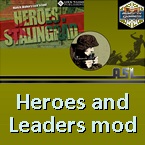asl3d
Posts: 6531
Joined: 2/6/2017
Status: offline

|
Both in the Baltic and in the Black Sea, the Soviets conducted more than 50 battalion-sized or larger amphibious landings. Multiple regimental+ sized operations were landed on the Black Sea (including some notable failures.) The Soviets also conducted many river crossings, and some of those rivers were wide enough that they might well be considered in the same realm as coastal amphibious operations.
In particular the Soviets developed the tactic of using river networks rather than just river banks, assembling their forces and boarding riverine watercraft on an uncontested river (both banks in friendly hands), and then transiting down to that river's confluence with a contested river (enemy holding the far bank) to effect a landing. In this way they could assemble flotillas of watercraft that were too large to be transported overland and launched within site of the enemy (river barges, armored boats like the BKA-1125, etc.). They also were masters at improvising, constructing improvised watercraft from available materials in rapid order to cross rivers which Axis forces left under-defended.
The PG 117 was used during second world war of Soviet Navy as fast boats for supporting infantry at landing operations, to transport supplies and patrol on rivers, lakes and harbors.
The Dnieper Flotilla's vessels contributed to the flank defense of advancing Soviet troops in the Ukraine, Belarus, and Poland, and enabled the crossing of water obstacles, provided logistic support, and performed amphibious landings – the largest being the Pinsk Landing during the liberation of that city, with others including landings at Zdudichi, Petrikovsky, Borkinsky, and Doroshevichinsky. Flotilla units continued fighting to end of the war, in battles on the Oder and Spree, and PG-117 motorboats of the Dnieper Flotilla participated in the storming of Berlin, the only naval units to do so. The riverine operations along the Danube in 1944 and 1945 are considered by the Soviets as amphibious.
A tactical landing has limited missions such as enveloping the flank of the enemy, but it is characterized as influencing the outcome of the battle on the theater's coastal sector. It is a supporting operation, usually lasting no more than a week, conducted usually by a battalion but possibly by a division. A raiding party is a small scale operation, a demonstration designed for very limited tasks such as creating panic in the enemy's rear or destroying a coastal artillery emplacement. The time of a raiding party is measured in hours and the inserted forces, often provided by a ship's company, require extraction.
The success of an amphibious operation hinges on the proper selection of landing sites, the timing of the landing, thorough preparation of all forces, and the need for secrecy in the preparation and execution of the landing.
For seizing a beachhead, the units conducting the spearhead seize an area with a depth of 300-600 meters from the shore to keep enemy machinegun fire away from the follow-on forces. Soon after, the beachhead should be expanded to a depth large enough to prevent the enemy from bringing in observed artillery fire.
Only in the Baltic Fleet had a unit formed by June 1941 which was intended especially for amphibious warfare, the 1st Special Marine Brigade organized in Leningrad in 1940. The deployment of this unit was not included in the mobilization plans drawn up in early 1941.12 Soon after the Germans kicked off Operation Barbarossa, the Soviet High Command recognized that similar units should be formed in all the fleets. Sailors were hastily enlisted from all types of ships and joined those recently released from hospitals and schools. Naval officers who had attended combined arms academies assumed many of the key command and staff billets.

 Attachment (1) Attachment (1)
_____________________________
Semper fidelis
|
 Printable Version
Printable Version






























 New Messages
New Messages No New Messages
No New Messages Hot Topic w/ New Messages
Hot Topic w/ New Messages Hot Topic w/o New Messages
Hot Topic w/o New Messages Locked w/ New Messages
Locked w/ New Messages Locked w/o New Messages
Locked w/o New Messages Post New Thread
Post New Thread